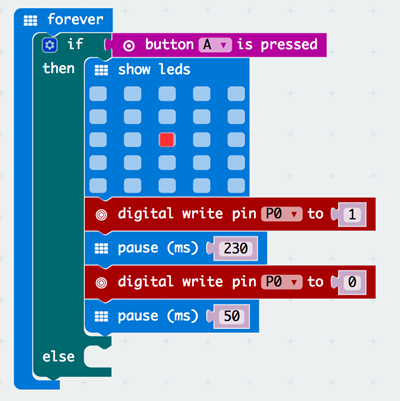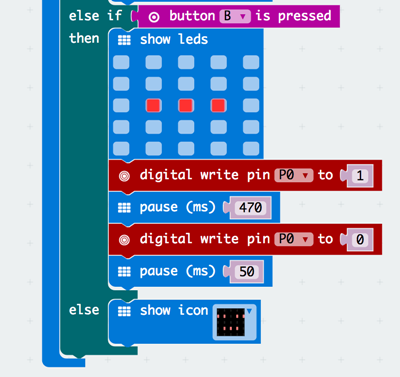case 31 morse code transmitter
Contents
34. case 31 morse code transmitter#
34.1. Morse Code Transmitter#
Make a simple morse code transmitter using MakeCode, micro:bits, and some crocodile clips! This tutorial was written by Anahita from the University of California at Berkeley, during her summer internship in Singapore.
34.2. Products Link#
34.3. Goals#
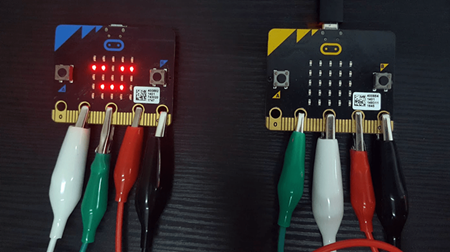
Connect two micro:Bits together.
Send signals from the first micro:Bit to the second micro:Bit by pressing the A and B buttons.
Receive signals from the first micro:Bit.
Learn how to code in MakeCode.
34.4. Materials#
2 x micro:Bits
4 x Crocodile Clips
1 x micro USB cable
34.5. Step 0 – Preview#
We will be writing two sets of code: one for the sending micro:Bit and another for the receiving micro:Bit
In order for the receiver to know which signal is being sent, we will adjust the length of time between when the signal turns “on” and “off”
That way, we can differentiate the two signals by the pause length
Step 1 – Crocodile Clips#
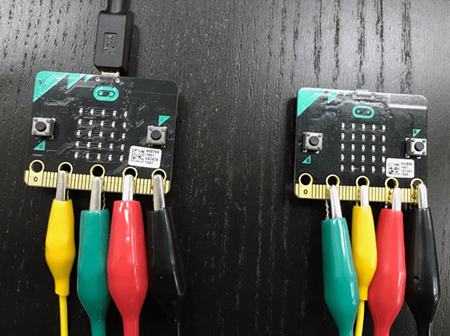
We want to send signals from pin 1 of the first micro:Bit to pin 2 of the second micro:Bit (and vice versa)
Connect:
GND to GND
3V to 3V
Pin 1 to Pin 2
Pin 2 to Pin 1
Step 4 – Receiver: detecting the signal#

We want to record the duration of time between whenever the signal is received and when it stops. We will be using the running time (ms) block for this.
Create another project on MakeCode called “Receiver”
Drag a while loop from the Loops drawer
From the Logic drawer, attach an equals sign block to the while loop
Attach a digital read pin block to the equals sign block and set it equal to 1(This means that a signal is being detected;Make sure to change it to p2 since that’s where the crocodile clip is)
In the Variables drawer, make a variable called “keyDownTime”
Attach an if-then block to the body of the while loop
Attach a not block from the Logic drawer to the if statement and then attach the keyDownTime variable to it
You can find the running time (ms) block by searching for it in the search bar
Step 5 – Receiver: displaying the signal#
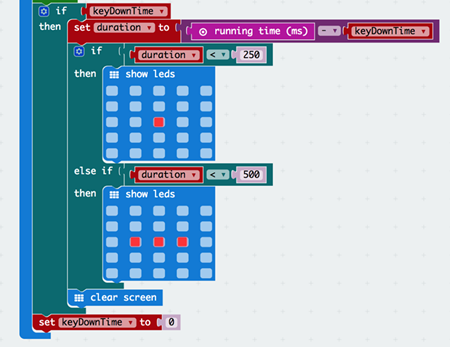
We want to display the correct signal on the screen.
Drag and drop an if-then block underneath the while loop and attach the keyDownTime variable to it(This is so that this block of code will only run if a signal has been detected)
Create another variable called “duration” and set it to be the difference between running time and keyDownTime(The minus operation is under the Math drawer,This variable tells us how long it’s been since the program started running and when the signal was detected)
Drag an if-then block and attach a less than block from the Logic drawer and make it so that it’s duration < 250(We chose 250 ms since the “dot” takes 230 ms)
Display the “dot” led in the body of the if statement
Add an else if block to the if-then-else block from earlier and do the same thing as above except the “dash” threshold is 500 since the “dash” takes 470 ms and then show the “dash” led
Add a clear screen so that the screen clear after a signal comes in
After the first if-then block make sure to set keyDownTime to 0 so that it works every time you send a new signal
34.6. Done!#
Make sure to flash the code to the respective micro:bits and test it out! It should display the same signal on both screen when you press a button.
For an added challenge, try to translate the morse code on the second micro:bit.

